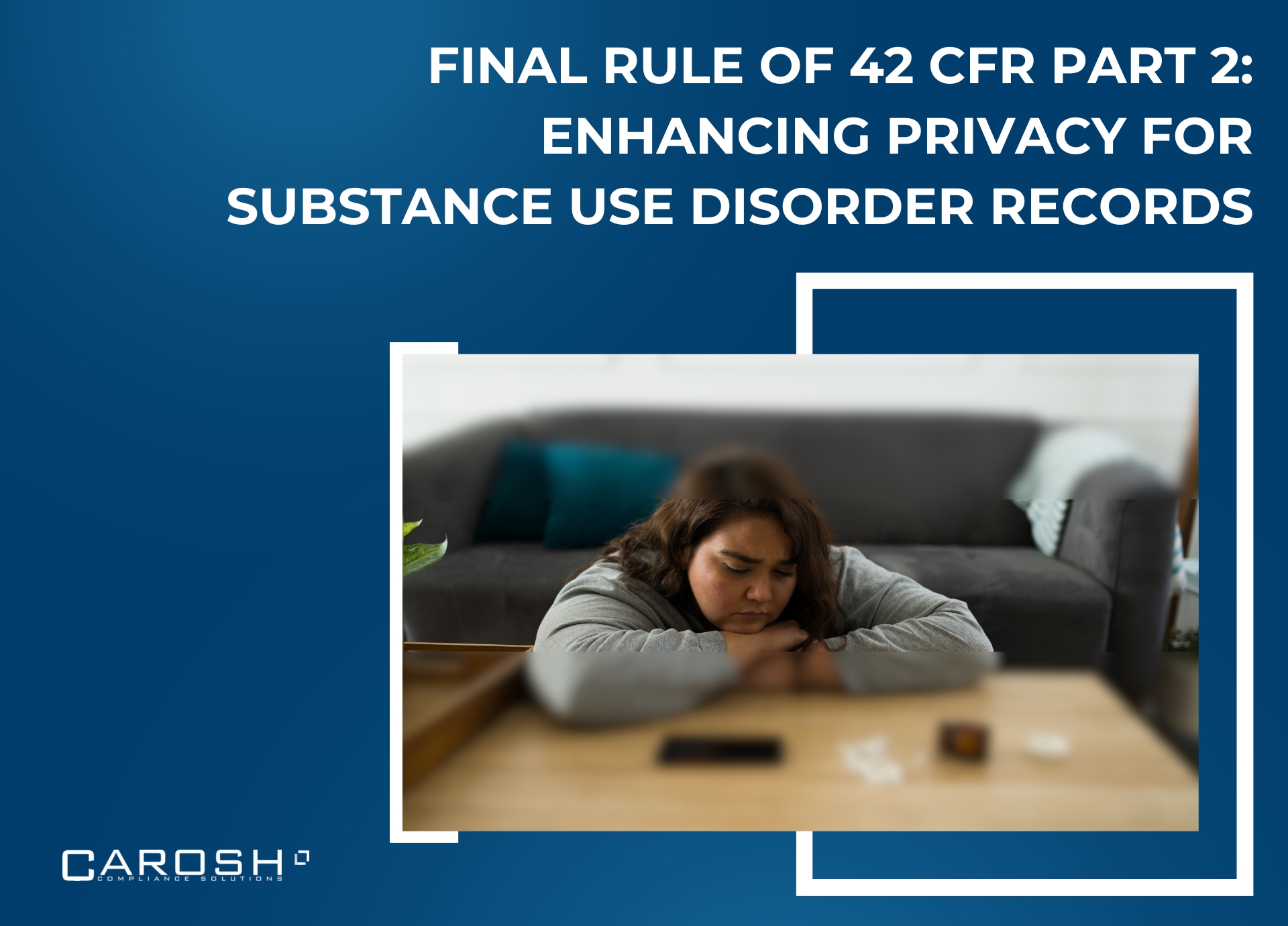
Content Table
Consent Requirements during SUD Treatment
Disclosure for Payment and Healthcare Operations
Re-disclosure during SUD Treatment
Security and Data Protection during SUD Treatment
The Final Rule of 42 CFR Part 2 stands as a significant step forward in securing substance use disorder (SUD) treatment records, setting it apart from the Health Insurance Portability and Accountability Act (HIPAA). This rule focuses on the confidentiality of SUD patient information, aiming to create a safer recovery environment. Historically, Part 2’s strict privacy standards have posed unique compliance challenges for healthcare providers. The latest updates aim to balance patient privacy needs with the growing demands of integrated healthcare delivery, addressing the complexities of modern healthcare while maintaining essential privacy protections for individuals undergoing SUD treatment.
Consent Requirements during SUD Treatment
Changing Consent Requirements
The 42 CFR Part 2 regulations recently updated consent requirements to improve healthcare interoperability and integrated care for people with substance use disorders (SUDs). These changes simplify how patients consent to share their SUD treatment information. Under the old rules, patients had to name individuals to whom they consented to share their treatment records, a requirement that hindered care coordination.
A More Flexible Approach
Now, the rule allows patients to consent to disclose their treatment information to categories of entities, like “my treating providers,” rather than naming individuals. This change means a patient’s SUD treatment information can be shared across a broader care network more easily, improving care coordination and treatment decision-making.
Impact on Integrated Health Systems
This adjustment is crucial for integrated health systems where patients receive care from multiple providers. It supports a collaborative approach to patient care, removing previous barriers to integrating SUD treatment into a comprehensive health plan.
Ensuring Privacy and Understanding
Despite this simplification, it’s vital to maintain strong privacy protections and ensure patients understand how their information will be used. Providers must clarify the implications of a general designation and ensure disclosures are limited to the minimum necessary information.
The Significance of Simplified Consent
The simplification of consent requirements in the 42 CFR Part 2 Final Rule is a significant step toward better care coordination and comprehensive health services delivery. It balances the need for essential information sharing with the need to maintain confidentiality in SUD treatment.
Disclosure for Payment and Healthcare Operations
Significant Updates in 42 CFR Part 2 for SUD Treatment Data
The Final Rule on 42 CFR Part 2 introduced crucial updates regarding the use and disclosure of data for patients undergoing substance use disorder (SUD) treatment, particularly outside of direct patient care. A key change aimed to increase flexibility in how healthcare providers and organizations manage Part 2-protected information, notably allowing its use and disclosure for essential administrative purposes, such as payment and healthcare operations. This adjustment seeks to find a middle ground between strict privacy protections and the operational needs of healthcare providers and systems.

Expanded Flexibility for Healthcare Operations
Under the revised rules, entities governed by Part 2 gained the ability to disclose necessary patient information for activities fundamental to healthcare services. These activities include claiming insurance payments, conducting healthcare quality assessments, improving patient safety measures, and other related healthcare operations. Yet, this expanded flexibility is accompanied by robust safeguards. The rule mandates that such disclosures must meet specific conditions to prevent compromising patient information confidentiality. For instance, disclosures for payment and healthcare operations require detailed agreements defining the allowed information uses and the steps necessary to protect it from unauthorized further disclosure.
Balancing Care Quality and Patient Privacy
This nuanced approach reflects the complexities of delivering high-quality, integrated care while protecting sensitive health information. By permitting the disclosure of Part 2-covered data for payment and healthcare operations, the Final Rule recognizes the practical needs of healthcare providers and organizations without undermining the privacy and trust of patients receiving SUD treatment. The protections included in this provision aim to guard against the misuse of patient information, ensuring disclosures are managed in a way that continues to protect patient privacy in SUD treatment contexts.
Re-disclosure during SUD Treatment
Clarifications on Re-disclosure under 42 CFR Part 2
The Final Rule on 42 CFR Part 2 introduced key clarifications around the re-disclosure of information for individuals undergoing substance use disorder (SUD) treatment. Initially protected under Part 2 regulations, this rule focuses on preserving the privacy and confidentiality of those seeking SUD treatment. The rule outlines specific instances where re-disclosure might be both necessary and allowed without requiring additional consent from the patient.
Original Provisions and the Need for Safeguards
Originally, Part 2 regulations restricted the re-disclosure of SUD treatment information shared with a third party, even with the patient’s consent, to further entities without acquiring more explicit consent. This critical safeguard aims to keep the patient’s treatment information confidential, encouraging individuals to seek SUD treatment without fear of privacy violations.

Guidelines for Permissible Re-disclosure
The Final Rule provides detailed guidelines on how and when re-disclosure can occur in a legal and ethical manner, defining precise scenarios where it’s permissible without further patient consent. For example, it allows for the sharing of information within a healthcare system for treatment, payment, or operations under specific agreements that protect the information and restrict its use.
Impact of the Final Rule
These clarifications are pivotal, offering healthcare providers, organizations, and other entities clear guidance on managing Part 2-protected information responsibly. By specifying the conditions for allowable re-disclosure, the Final Rule supports the integrity of patient care and operational processes in healthcare systems, balancing efficient care delivery with the imperative to safeguard individuals’ privacy rights in SUD treatment.
Security and Data Protection during SUD Treatment
Enhancing Security for Electronic SUD Treatment Records
The Final Rule on 42 CFR Part 2 introduced strict requirements for securing electronic records of substance use disorder (SUD) treatment. These new rules aim to protect electronically stored SUD treatment records from unauthorized access, use, or disclosure, similar to the security measures of the Health Insurance Portability and Accountability Act (HIPAA) Security Rule. This focus on electronic records highlights the increasing use of digital platforms and electronic health record (EHR) systems in healthcare, emphasizing the importance of safeguarding digital patient information.
Implementing Robust Security Measures
To comply with these security requirements, healthcare providers and entities dealing with SUD treatment information must implement strong security measures. This includes administrative, physical, and technical safeguards like access controls, encryption, and protocols for secure data transmission. Aligning Part 2’s security requirements with those of the HIPAA Security Rule helps create a unified framework for protecting sensitive health information across healthcare sectors.

Addressing Digital Vulnerabilities
The emphasis on securing electronic SUD treatment records in the Final Rule addresses the vulnerabilities of digital data storage and transmission. It acknowledges the specific privacy concerns surrounding SUD treatment and the necessity for advanced security measures to preserve patient confidentiality and trust. By setting clear standards for the protection of electronic SUD treatment information, the updates play a crucial role in the ongoing effort to protect patient privacy in the digital era. This ensures that individuals seeking SUD treatment can trust that their information will remain secure against potential breaches.
Breach Notification
Potential Alignment with HIPAA’s Breach Notification Rule
Historically, Part 2 regulations have not included a breach notification requirement like the one in the Health Insurance Portability and Accountability Act (HIPAA). However, there’s ongoing debate and recommendations about aligning Part 2 with HIPAA’s Breach Notification Rule. Such an alignment would require notifying individuals promptly when there’s an unauthorized disclosure of their substance use disorder (SUD) treatment records. This discussion highlights the evolving nature of patient privacy protections and the need for consistent and comprehensive responses to privacy breaches across healthcare.
Implications of a Breach Notification Requirement
Introducing a breach notification requirement similar to HIPAA‘s would significantly change the protection of SUD treatment information. It emphasizes transparency and patient rights after a breach. This requirement would ensure individuals are informed about breaches of their sensitive health information quickly, allowing them to take steps to reduce potential harm. Moving towards alignment with HIPAA’s Breach Notification Rule mirrors a broader trend of harmonizing privacy protections across healthcare. It aims to give patients a uniform standard of care and protection, regardless of their health information type.
Enhancing Patient Trust and Security
The discussion about adding a breach notification requirement to Part 2 balances the need to keep SUD treatment records confidential and ensure patients are well-informed and protected in today’s digital healthcare landscape. By aligning with HIPAA’s standards, policymakers and healthcare providers seek to improve trust and security in the SUD treatment process. They recognize protecting patient information as a key component of quality care and treatment outcomes.
The Final Rule of 42 CFR Part 2 marks a crucial advance in protecting individuals with SUDs. It clarifies consent requirements and permits more flexible information sharing, balancing privacy protections with improved care coordination. Healthcare providers must carefully comply with these regulations, upholding privacy and trust in SUD treatment. As healthcare evolves, staying informed and adaptable to regulatory changes remains essential for everyone involved in caring for individuals with SUDs.
Q&A Section
Q: What is the purpose of the 42 CFR Part 2 Final Rule?
A: The Final Rule aims to protect the privacy of individuals seeking treatment for substance use disorders by setting stringent standards for the handling and disclosure of their treatment information, thereby encouraging more individuals to seek recovery services without fear of stigma or discrimination.
Q: How does the 42 CFR Part 2 Final Rule differ from HIPAA?
A: While HIPAA provides broad regulations for protecting all patient health information, 42 CFR Part 2 offers more specific protections for SUD treatment records, often imposing stricter limitations on the use and disclosure of this type of information.
Q: What are the key updates in the Final Rule of 42 CFR Part 2?
A: Key updates include simplified consent requirements to facilitate care coordination, allowances for disclosure for payment and healthcare operations with protections, clarifications on re-disclosure, and enhanced security measures for electronic records.
Q: How does the Final Rule impact healthcare providers and organizations?
A: Healthcare providers and organizations dealing with SUD treatment information must navigate both HIPAA and Part 2 regulations, applying the most protective standards to ensure compliance and protect patient privacy effectively.




